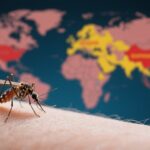Plastics are woven into the fabric of modern life—from food packaging and medical devices to clothing and electronics. Yet, their durability, once celebrated, has become a global liability. Over 400 million tons of plastic are produced annually, and a staggering 30,000 tons enter the world’s oceans every day. As plastics break down, they release micro- and nanoplastics (MnP) and a cocktail of toxic additives, raising alarms about their effects not just on wildlife, but on human health and the planet’s ecosystems.
The urgency of this crisis has brought world leaders and experts together to negotiate a binding international treaty on plastic pollution. At the heart of these discussions are mounting concerns over how plastics—and especially the tiny fragments and chemicals they shed—may disrupt hormones, increase cancer risk, impair fertility, and threaten respiratory health. WWF and the University of Birmingham’s recent report, “Plastics, Health, and One Planet,” synthesizes nearly 200 studies, arguing that decisive action must be taken, even as research continues to evolve.
Scientific and Clinical Evidence: What the Data Tell Us
Plastics do not simply vanish; they fragment into microplastics (less than 5mm) and nanoplastics (less than 100 nm), infiltrating water, soil, air, and ultimately, our bodies. The human exposure pathways are diverse: we ingest MnPs in food and water, inhale airborne particles, and absorb chemicals through skin contact. But what does science say about their effects?
Endocrine Disruption and Cancer: Many plastic additives, such as phthalates, bisphenol A (BPA), and certain flame retardants, are recognized endocrine disruptors. These chemicals can mimic or block hormones, interfering with the body’s regulatory systems. Studies link them to increased risks of hormone-related cancers, including breast and testicular cancer, as well as developmental disorders and metabolic disease (Trasande et al., 2022).
Reproductive and Fertility Impairments: Both animal and epidemiological research suggest that MnP and plastic-associated chemicals can damage reproductive organs, reduce sperm quality, and impair fertility in both men and women (Wang et al., 2023).
Respiratory and Immune Effects: Inhaled microplastics have been detected deep in human lung tissue. Laboratory studies indicate they can promote inflammation, disrupt cell function, and may exacerbate chronic respiratory conditions such as asthma (Prata et al., 2020).
Wildlife and Ecosystem Health: Marine animals ingest plastics, which can accumulate up the food chain, potentially reaching humans. Plastic pollution also disrupts the habitats and reproductive cycles of countless species, compounding biodiversity loss.
Case Vignette: Jessica’s Story
Jessica, a 34-year-old teacher from Ohio, was diagnosed with unexplained infertility. After years of fruitless attempts at conception, her physician recommended testing for environmental exposures. Jessica’s bloodwork revealed elevated levels of phthalates and BPA—chemicals commonly found in plastics. While these findings do not prove causation, they echo a growing scientific consensus: our plastic-filled world is not without consequence.
Misconceptions and Harmful Behaviors
Despite mounting evidence, several misconceptions persist:
- “Plastics are inert and harmless.” Many assume plastics are chemically stable, yet additives can leach out, especially when plastics are heated or degraded.
- “Recycling solves the problem.” Only about 9% of plastics are recycled globally, and most plastic products are not designed for easy or safe recycling. Recycling does not address the microplastic burden or the toxicity of certain additives.
- “Microplastics only affect marine life.” Microplastics are found in drinking water, table salt, fruits, vegetables, and even the air we breathe. Human exposure is ubiquitous.
Correct Health Practices and Practical Recommendations
While policy change is essential, individuals can take steps to reduce their exposure and environmental impact:
- Limit the use of single-use plastics (bottles, bags, straws, packaging).
- Avoid microwaving food in plastic containers; use glass, ceramic, or stainless steel instead.
- Choose products labeled “phthalate-free” and “BPA-free,” though be mindful that alternatives may also carry risks.
- Support and participate in local recycling and plastic reduction initiatives.
- Advocate for cleaner water supplies and stricter limits on plastic additives.
Table: Common Plastic Additives and Health Risks
| Additive | Common Uses | Potential Health Effects |
|---|---|---|
| Phthalates | Flexible plastics, cosmetics, toys | Endocrine disruption, fertility issues, developmental effects |
| BPA | Food can linings, water bottles, receipts | Hormone disruption, cancer risk, metabolic disorders |
| PBDEs (flame retardants) | Electronics, furniture, textiles | Neurodevelopmental toxicity, thyroid disruption |
| PFAS | Non-stick cookware, waterproof textiles | Immune suppression, cancer, reproductive effects |
Expert Insights and Commentary
Professor Stefan Krause, University of Birmingham, asserts, “The precautionary principle has guided multiple international agreements with great success, notably the 1987 Montreal Protocol, when countries acted decisively on ozone-depleting substances before the science was fully settled, preventing millions of cases of skin cancer and facilitating the restoration of the ozone layer. Building on this precedent, we urge governments and negotiators to deliver a science-based, legally binding treaty that not only tackles plastic pollution at its roots by including global bans and phase-outs of the most harmful products and chemicals, but also makes protecting human, wildlife, and environmental health a core function.”
Zaynab Sadan, Global Plastics Policy Lead at WWF, emphasizes, “In a world of shifting politics, these negotiations are on a knife edge. The ambitious majority must now forge their own path to a meaningful treaty through voting or forming a majority coalition. By rejecting bad-faith obstruction and leveraging their strength in numbers, the ambitious majority can build a treaty that helps protect people now and for generations to come. They have the support and they have the tools. Now they need to deliver.”
The Path Forward: Treaty, Policy, and Personal Action
Experts and advocates are calling for a treaty that enshrines:
- Global bans on the most harmful plastic products and chemicals.
- Product design requirements to enable a non-toxic circular economy.
- Financial and technical support for developing countries to ensure effective implementation.
- Mechanisms to strengthen and adapt the treaty over time.
The upcoming negotiations in Geneva (INC-5.2) may represent a turning point. If history is a guide, bold, collective action—guided by science and the precautionary principle—can avert harm before it becomes irreversible. Waiting for absolute certainty risks further endangering health, ecosystems, and future generations.
Conclusion
Plastic pollution is not just an environmental issue; it is a public health emergency. While individuals can make choices to reduce exposure, the scale and complexity of the problem demand coordinated, international action. A robust, legally binding treaty could set the stage for a healthier, more sustainable future—protecting people, wildlife, and the planet itself. The time to act is now.
References
- WWF & University of Birmingham. Plastics, Health, and One Planet: A Synthesis of the Evidence. 2024. https://www.wwf.org.uk/sites/default/files/2024-07/WWF_Plastics_Health_and_One_Planet_Report.pdf
- Trasande, L., et al. (2022). “Phthalates and human health.” Annual Review of Public Health, 43, 345–361.
- Wang, J., et al. (2023). “Microplastics and human health: Impacts, mechanisms, and prevention.” Environmental Science & Technology, 57(12), 4313–4328.
- Prata, J.C., et al. (2020). “Environmental exposure to microplastics: An overview on possible human health effects.” Science of the Total Environment, 702, 134455.
- United Nations Environment Programme. “Negotiating a global treaty to end plastic pollution.” 2024. https://www.unep.org/plastic-pollution-treaty
- https://www.birmingham.ac.uk/news/2025/global-plastic-pollution-treaty-essential-to-tackle-growing-health-risks-to-all-life-on-earth



